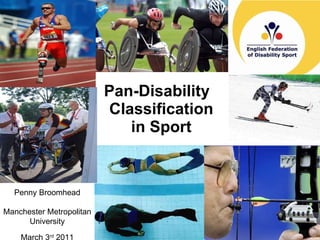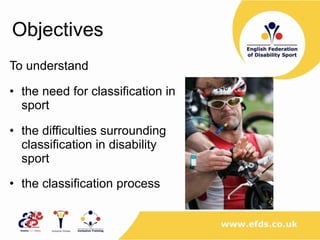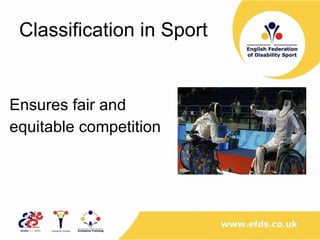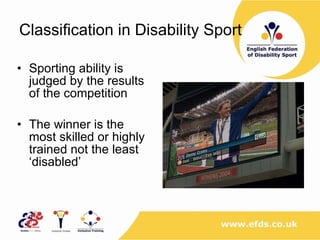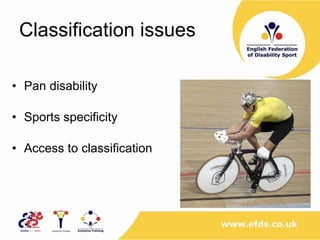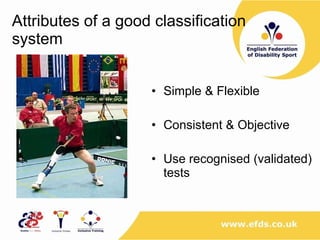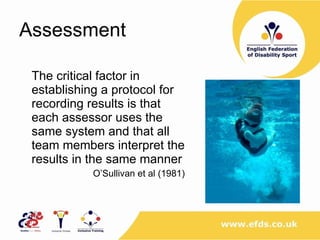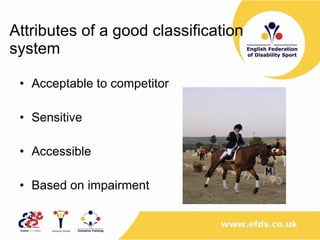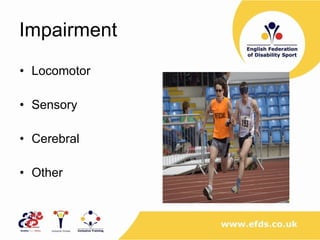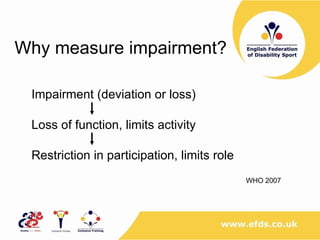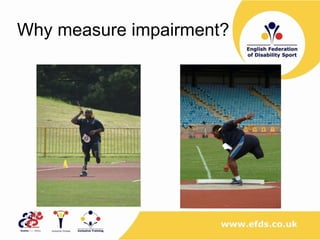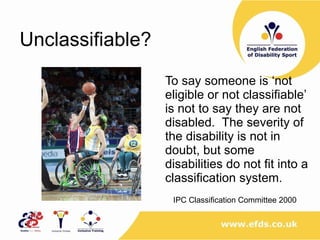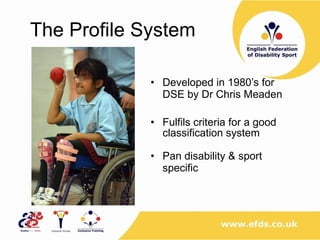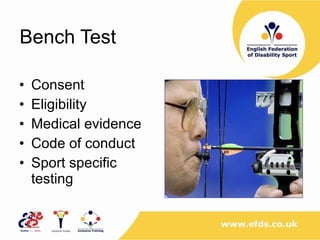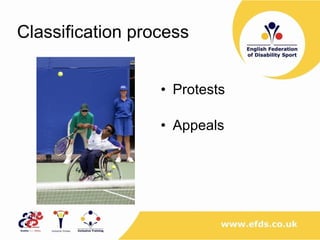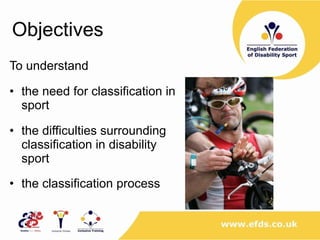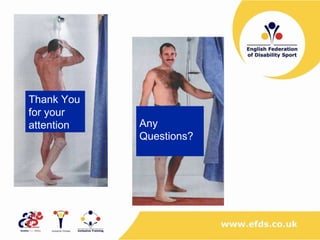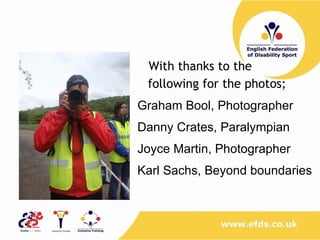Efds classification presentation 02.03.11
- 1. Pan-Disability Classification in Sport Penny Broomhead Penny Broomhead Manchester Metropolitan University March 3 rd 2011
- 2. Objectives To understand the need for classification in sport the difficulties surrounding classification in disability sport the classification process
- 3. Classification in Sport Ensures fair and equitable competition
- 4. Classification in Disability Sport Sporting ability is judged by the results of the competition The winner is the most skilled or highly trained not the least âdisabledâ
- 5. Classification issues Pan disability Sports specificity Access to classification
- 6. Attributes of a good classification system Simple & Flexible Consistent & Objective Use recognised (validated) tests
- 7. Assessment The critical factor in establishing a protocol for recording results is that each assessor uses the same system and that all team members interpret the results in the same manner OâSullivan et al (1981)
- 8. Attributes of a good classification system Acceptable to competitor Sensitive Accessible Based on impairment
- 9. Impairment Impairments are problems in body function or structure such as a significant deviation or loss. WHO 2000
- 10. Impairment Locomotor Sensory Cerebral Other
- 11. Why measure impairment? Impairment (deviation or loss) Loss of function, limits activity Restriction in participation, limits role WHO 2007
- 13. Unclassifiable? To say someone is ânot eligible or not classifiableâ is not to say they are not disabled. The severity of the disability is not in doubt, but some disabilities do not fit into a classification system. IPC Classification Committee 2000
- 14. The Profile System Developed in 1980âs for DSE by Dr Chris Meaden Fulfils criteria for a good classification system Pan disability & sport specific
- 15. Classification process Bench test Observation in competition Protests Appeals
- 16. Bench Test Consent Eligibility Medical evidence Code of conduct Sport specific testing
- 17. Classification status process not complete until observed in competition Status Confirmed Review
- 18. Classification process Protests Appeals
- 19. Interested? Attend a classification course to be able to assess athletes for eligibility & training to be able to accompany an athlete through the process
- 20. Objectives To understand the need for classification in sport the difficulties surrounding classification in disability sport the classification process
- 21. Thank You for your attention Any Questions?
- 22. With thanks to the following for the photos; Graham Bool, Photographer Danny Crates, Paralympian Joyce Martin, Photographer Karl Sachs, Beyond boundaries
Editor's Notes
- #5: Enables people with similar degrees of function to compete as fairly as possible
- #6: Evolved with the growth of disability sport IPC classification code Apples & pears Athletics, rowing, cycling, swimming IWAS, INAS-FID, CP ISRA
- #7: Read slide; simple, flexible, consistent & objective, using validated, recognised tests makes it repeatable so different assessors would get the same result, if it is fair it will be acceptable to competitors Needs to be sensitive to what it is measuring, to be able to identify and differentiate. Reason I feel so strongly about classification because of Colin; UL amp & hemi on other side. Hadnât been classified in Uk, went to Barcalona & ISOD system couldnât classify him, not sensitive or flexible enough to cope with both amp & hemi on opposite sides. Had to compete as a guest, gutted. Look what happened to Jenny Ridley in Athens, classified out of competition she had been preparing years for. It shouldnât have happened to either of them, so classification needs to be accessible. Every GB competitor should have opportunity to be classified in this country in own language before going abroad to compete. There arenât enough classifiers in this country & Iâll explain why later. Also & NB , needs to be based on impairment. What is that & why?
- #9: Read slide; simple, flexible, consistent & objective, using validated, recognised tests makes it repeatable so different assessors would get the same result, if it is fair it will be acceptable to competitors Needs to be sensitive to what it is measuring, to be able to identify and differentiate. Reason I feel so strongly about classification because of Colin; UL amp & hemi on other side. Hadnât been classified in Uk, went to Barcalona & ISOD system couldnât classify him, not sensitive or flexible enough to cope with both amp & hemi on opposite sides. Had to compete as a guest, gutted. Look what happened to Jenny Ridley in Athens, classified out of competition she had been preparing years for. It shouldnât have happened to either of them, so classification needs to be accessible. Every GB competitor should have opportunity to be classified in this country in own language before going abroad to compete. There arenât enough classifiers in this country & Iâll explain why later. Also & NB , needs to be based on impairment. What is that & why?
- #10: Who definition of impairment is
- #11: Impairment can be divided into Locomotor; amputation, Sensory; blind, deaf Cerebral; intellectual/psychological Other; visceral eg renal failure Paresis, amp[utation, joint ankylosis, Upper motor neurone lesions, loss of sight, Intellectual disabiliity These are permanent impairments
- #12: Why measure impairment & not disability or handicap? Impairment is the bottom line & it won't change. You have an amputation or you donât, It can be measured objectively. The impairment causes a disability or loss of function, but if you measure disability (loss of ability) by functional testing then someone with a severe impairment who has trained, overcome their impairment to some degree and become skilful would be considered minimally disabled because they have reduced their lack of ability. Well, why not handicap? Defined by WHO as limiting or preventing role. Not everyone who has a disability has a handicap & similar disabilities can have different handicaps How do you measure that objectively? David Blunkett,Jack Ashley,Heather McCartney Franklin D Roosevelt,Stephen Hawkins,Michael Caines May well not feel handicapped by their disability and have overcome their impairment to be successful in society But think of Mozart, his impairment disabled and handicapped him
- #13: If we apply that argument to this field athlete His impairment is that he is a trans-femoral amputee. He uses a prosthesis to run up to throw the javelin and without his prosthesis he has developed superb balance to shot put. We canât classify him differently for each event he participates in and we canât penalise him for his skill and training so he is classified by his impairment, which wonât change and can be directly & objectively compared with another trans-femoral amputee. If we were classifying him on his disability he would be penalised for overcoming his impairment and developing such amazing balance. So classification is based on impairment & groups those with the potential to have the same ability, if they have the talent & training. If they win it is because of their skill. .
- #14: There are some people who are Unclassifiable. They may be quite disabled by pain, fatigue (ME), numbness, ligamentous instability but these things may not be permanent and they may not be objectively measurable. These people do not meet the conditions for minimal functional disability of the classification system ( another reason why a sensitive test is so important) but they can still participate in their chosen sport.
- #15: Enables (flexible) grouping for different sports Grassroots to elite level the Profile System has been used at Paralympic Games since 2000 and for International competition for Disabled people and World Equestrian Competition since 1997. It was also used for International Triathlon competition in 2007. That was a brief look at the theory & philosophy, now lets look at an example of good practice in classification The profile system was devised by CM for DSE Its strength is that it is not sport specific or disability specific as others are, so competitor categorised for any sport, used in UK for juniors up to national level& some adults in some sports up to regional level, It can be used at grassroots level up to the point where a competitor enters open or international competition Unlike other systems if avoids need for assessors to have specialist knowledge These 2 things make it very accessible. I said earlier that there arenât enough classifiers in this country. The profile system goes some way to addressing that because it is so accessible. But it has not been adopted internationally by many sports, at present only equestrian & triathlon. These 2 very different sports prove the point about its flexibility.
- #16: Client interview â basic relevant information Selection of one of three scales Conduct the examination Score â use assistance if available Consult graphics Match Scores to graphics Select Profile â Thus select Grade/Class
- #17: Prior to event Allowed to be accompanied by parent, coach or team manager Companion not allowed to contribute Should warm up May need technical testing eg swimming Consent ANC disqualified

